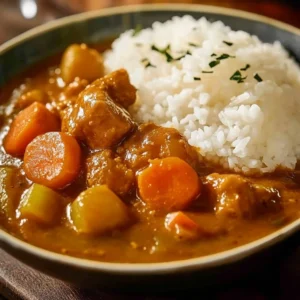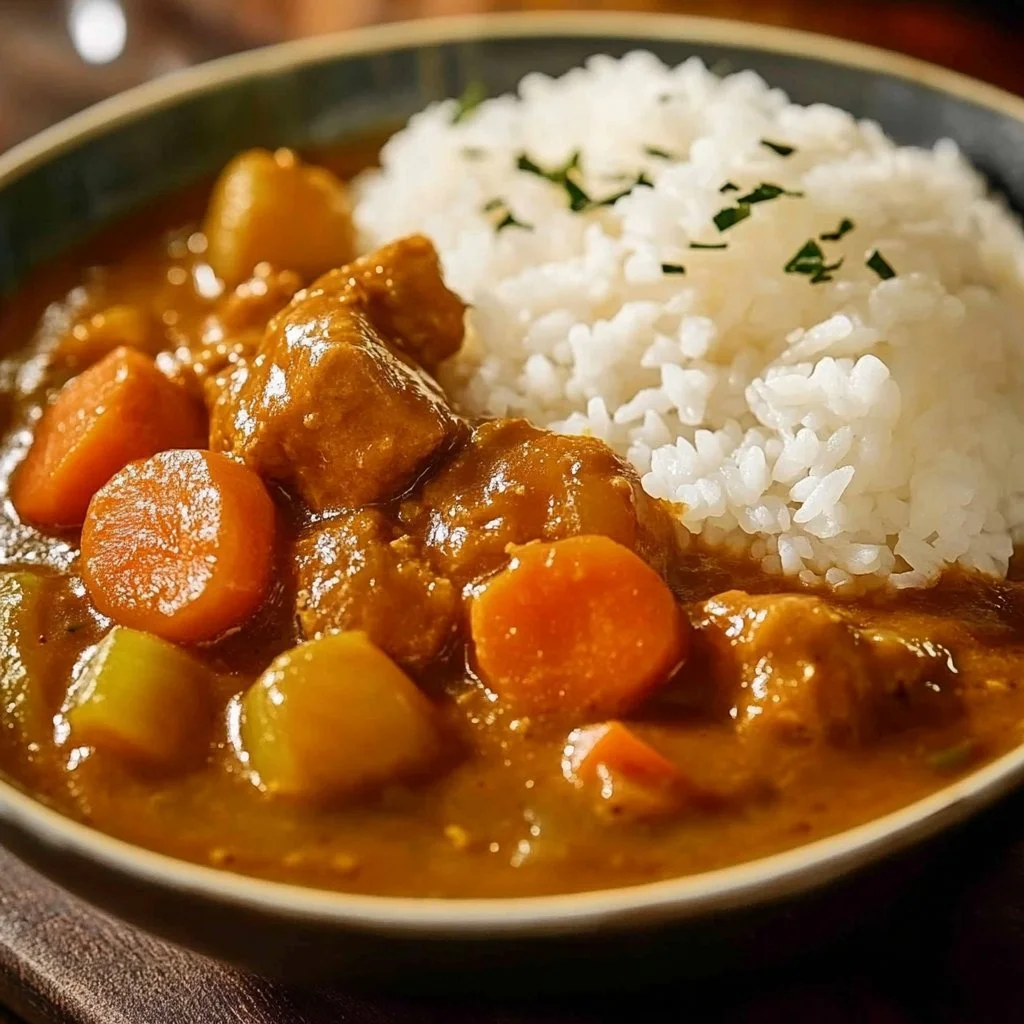This post may contain affiliate links. As an Amazon Associate, I earn from qualifying purchases at no extra cost to you.
Table of Contents
Japanese Curry on Rice is a delightful dish that combines the comforting flavors of curry with the heartiness of rice. Have you ever found yourself craving something warm, savory, and downright delicious? This recipe is not only scrumptious but also incredibly simple to prepare. Imagine soft, tender vegetables simmered in a richly flavored curry sauce, served over a fluffy bed of rice.
It’s the kind of meal that embraces you like a warm hug and fills your kitchen with an irresistible aroma that will have everyone gathering around the table. Japanese Curry on Rice is the perfect meal for any day of the week, whether it’s a busy Monday night or a leisurely weekend feast. Are you ready to dive into the delightful world of Japanese Curry on Rice? Let’s embark on this flavorful journey together!
🍴 Top Kitchen Essentials You'll Love
Key Benefits of Japanese Curry on Rice
Why You’ll Love This Recipe
- Quick and Easy Preparation: This recipe is straightforward, making it perfect for novice cooks. With just a few ingredients and minimal prep work, you can whip up a delicious meal in under an hour. It’s all about convenience without sacrificing flavor.
- Versatile Ingredients: Japanese Curry on Rice allows you to get creative in the kitchen. You can easily tailor the recipe to suit your tastes or what you have on hand. Whether you prefer chicken, beef, tofu, or just want to pack in more vegetables, the possibilities are endless.
- Nutritional Powerhouse: Packed with wholesome vegetables like carrots and potatoes, this curry dish is not only tasty but also nutritious. Adding protein further boosts the meal, providing energy for your day.
- Satisfying Comfort Food: There’s something incredibly comforting about a warm bowl of curry over rice. The blend of spices and savory flavors makes it a satisfying choice for any meal, especially on cold or rainy days.
- Great for Meal Prep: Japanese Curry on Rice holds up well in the refrigerator and makes for excellent leftovers. You can make a big batch and enjoy it throughout the week, saving time and effort on busy nights while still enjoying delicious homemade meals.
- Family-Friendly: Kids and adults alike love the sweet and savory notes of Japanese curry. It’s a dish that appeals to a wide range of palates, making it easy to share with family and friends.
What Makes It Stand Out
What makes Japanese Curry on Rice truly stand out from other curry recipes is its distinctive flavor profile. Unlike some curries that focus heavily on heat or spice, Japanese curry is generally mild and slightly sweet. This unique balance makes it approachable for those who may shy away from spicier dishes. The use of curry roux—special blocks that dissolve into the sauce—contributes to its smooth and rich texture. This technique eliminates the need for a long list of spices, streamlining the cooking process without losing depth of flavor.
Additionally, serving the curry over fluffy Japanese rice elevates the complete meal. The rice absorbs some of the curry sauce, creating a perfect harmony of flavors in each bite. Unlike other curry dishes that might be served in a bowl separately, the Japanese Curry on Rice method unites the elements, encouraging everyone to dig in and enjoy together. It embodies the essence of home cooking and brings people closer, making mealtime an event to cherish.
Ingredients for Japanese Curry on Rice
Complete Ingredient List with Measurements
To make delectable Japanese Curry on Rice, you’ll need the following ingredients:
- 2 tablespoons vegetable oil: This oil is used for sautéing the vegetables. You can also explore other refined oils that have a neutral flavor.
- 1 onion, diced: Onions add sweetness and depth to the dish, forming the base flavor.
- 2 carrots, chopped: These add a lovely sweetness to the curry and provide color.
- 2 potatoes, cubed: Potatoes offer heartiness and absorb the curry flavors beautifully.
- 2 cups water: This creates the curry sauce base. Adjust according to the desired thickness.
- 1 package Japanese curry roux: This is key to achieving that characteristic taste. You can find it in Asian grocery stores or online.
- 2 cups cooked rice: While Japanese short-grain rice is preferred, any type of cooked rice can work in a pinch.
- Optional protein (chicken, beef, or tofu): Choose your favorite protein to include in the dish for added nutrition and substance.
- Green peas or other vegetables: Feel free to add any other veggies that you love or have on hand for extra flavor and nutrition.
Substitutes and Alternatives
When making Japanese Curry on Rice, it’s important to consider dietary needs or preferences. Luckily, this recipe offers several substitutions. For those allergic to certain ingredients or following specific diets, here are a few options:
- Protein Alternatives: If you’re avoiding meat, tofu or tempeh can be excellent substitutes. Additionally, chickpeas or lentils can add a nice texture and protein without any animal products.
- Vegetable Variations: For those who prefer different vegetables, bell peppers, zucchini, or even spinach add delightful flavors and nutrients. You can go seasonal and use whatever you have available.
- Gluten-Free Options: Look for gluten-free Japanese curry roux or make a homemade blend of spices to avoid gluten. You can use cornstarch mixed with water as a thickening agent instead.
- Rice Substitutes: If you’re looking for a lower-carb option, consider serving your curry with cauliflower rice or quinoa.
Experimenting with alternatives can help you customize your Japanese Curry on Rice to fit your health goals or simply to suit your cravings!
How to Make Japanese Curry on Rice – Step-by-Step Directions
Step 1 – Prepare Your Workspace and Ingredients
Before diving into cooking, it’s essential to prepare your workspace. Gather all your ingredients to the counter, ensuring everything is easy to reach. This recipe comes together smoothly, so having a tidy, organized space can make a huge difference. Start by washing and peeling your vegetables. Dice the onion, chop the carrots, and cube the potatoes into bite-sized pieces. Having uniform sizes helps them cook evenly. If you’re using protein, prepare it by cutting it into small, bite-sized pieces. This preparation will save you time and allow the flavors to meld beautifully when cooking.
Step 2 – Heat the Vegetable Oil
Once your ingredients are prepped, place a large pot over medium heat and add the vegetable oil. Allow the oil to heat for a minute or two. You’ll know it’s ready when it shimmers slightly or a small piece of onion sizzles upon contact. This will help sauté the onion and release its sweetness into the dish.
Step 3 – Sauté the Onions
Now it’s time to add the diced onion to the pot. Stir continuously and cook them until they’re translucent, usually around 5 minutes. The goal is to release their natural sugars and develop a rich, savory base for your curry. Pay attention to the aroma, as it will fill your kitchen and get your taste buds excited for what’s to come.
Step 4 – Add the Carrots and Potatoes
Next, toss in the chopped carrots and cubed potatoes. Stir them into the mix, allowing them to coat in the oil and the onion’s fragrance. Let them cook for a few minutes; this helps build flavor and allows the vegetables to soften slightly before adding the water. You’ll want the vegetables to start feeling tender but not fully cooked just yet.
Step 5 – Pour in Water and Bring to a Boil
After a few minutes of sautéing, it’s time to pour in the water. Add it gently to the pot, ensuring that it covers the vegetables. Turn the heat up slightly to bring the mixture to a boil. This step is key as it allows the flavors to start coming together. Once you see bubbles rising to the surface, reduce the heat to a simmer.
Step 6 – Simmer Until Vegetables are Tender
Let the mixture simmer gently for about 15–20 minutes. This will ensure that the carrots and potatoes are cooked through while absorbing all the wonderful flavors. Stir occasionally to prevent anything from sticking to the bottom of the pot. As the vegetables soften, they will release their natural sweetness into the curry.
Step 7 – Stir in the Curry Roux
After your vegetables have become tender, it’s time to add the Japanese curry roux. Break it up into smaller pieces and stir it into the pot until it dissolves completely. The roux will transform the broth into a rich, smooth sauce with a delightful aroma. Keep stirring until the sauce thickens to your desired consistency. If it seems too thick, feel free to add a little more water to loosen it up.
Step 8 – Add Optional Proteins and Vegetables
If you chose to include any protein or extra vegetables, this is the time to add them to the pot. Stir them in gently, allowing them to cook until fully heated through. If you’re using cooked meat, it just needs warming; raw proteins will require additional cooking time, so adjust according to their specific needs.
Step 9 – Serve the Curry Over Cooked Rice
Once everything is cooked and deliciously fragrant, it’s time to serve. Prepare bowls of the cooked rice as your base. Spoon generous portions of the curry mixture over each serving. The sauce will meld perfectly with the rice, creating a meal that’s flavorful and comforting.
Step 10 – Enjoy the Flavors Together
With everything plated, take a moment to admire your work. Japanese Curry on Rice is best enjoyed fresh, so gather your loved ones around the table and dig in! The combination of textures and flavors will surely have everyone coming back for seconds.
Serving Suggestions for Japanese Curry on Rice
Best Occasions to Serve This Dish
Japanese Curry on Rice is incredibly versatile, making it suitable for various occasions. It’s a fantastic option for family dinners, quickly satisfying hungers after busy days. You can proudly serve it during casual gatherings with friends or even on special occasions like birthdays. The dish’s simplicity belies its comfort, perfect for keeping both kid and adult palates happy. And if you’re looking for something that encourages sharing, this recipe is a great choice. It beautifully highlights the essence of home-cooked meals where everyone can enjoy the warm flavors together.
What to Serve With It
When it comes to pairings, consider serving Japanese Curry on Rice with pickled vegetables called “fukujinzuke.” Their slight tanginess complements the richness of the curry, balancing flavors perfectly. For something refreshing, a light salad with a citrusy dressing can provide a nice contrast. Or, if you’re feeling adventurous, serve it alongside steamed dumplings or gyoza to create an Asian-inspired feast. As for beverages, green tea or a light beer can accentuate the meal, enhancing the flavors without overpowering them.
How to Store Japanese Curry on Rice Properly
Best Storage Practices
To store leftover Japanese Curry on Rice, allow it to cool to room temperature up to two hours after cooking. Transfer it into airtight containers, separating the curry from the rice if possible. This separation keeps the rice from becoming mushy. Properly stored, the curry can last up to four days in the refrigerator. When reheating, ensure that it is heated thoroughly, reaching at least 165°F (74°C) before consuming.
Reheating and Freezing Tips
If you want to keep some for a longer duration, consider freezing the curry. Place it in airtight containers or freezer bags, removing as much air as possible to prevent freezer burn. When you’re ready to enjoy your curry again, thaw it overnight in the refrigerator before reheating. Reheat gently on the stove or in the microwave until warm. If frozen in portions, it should maintain quality for about three months.
Tips & Tricks for Japanese Curry on Rice
Mistakes to Avoid
- Overcooking the Vegetables: They should be tender but not mushy. Keep an eye on them while simmering.
- Not Stirring Enough: This can lead to sticking and burning. Make sure to stir occasionally.
- Skipping the Roux: The roux is essential for flavor and texture. Don’t forget to include it.
- Neglecting to Taste: Always taste as you go. This helps you adjust seasoning before serving.
- Using Too Much Water: This can dilute the flavor. Add gradually and adjust as necessary.
- Serving Cold Rice: Ensure your rice is hot when serving for the best experience.
- Ignoring Leftovers: Don’t waste food! Leftover curry is often even tastier the next day.
- Skipping Garnishes: Fresh herbs or pickles can elevate the dish.
Extra Tips for Better Results
To enhance your Japanese Curry on Rice, consider the following practical ideas. Experiment with adding different ingredients like apple for a sweet twist or a bit of soy sauce for depth of flavor. If you like heat, a dash of chili powder or hot sauce can be an exciting addition. For an extra creamy texture, try incorporating coconut milk towards the end of cooking. Finally, topping your dish with some sesame seeds or freshly chopped green onions can add a nice crunch and color, making it look even more appetizing.
Recipe Variations of Japanese Curry on Rice
Creative Twists
There are numerous creative ways to adapt Japanese Curry on Rice to keep things exciting.
Seafood Curry: Swap out traditional proteins for shrimp or fish. The seafood will cook quickly and impart a delightful flavor to the curry.
Vegetarian Delight: Amp up your vegetable intake by incorporating items such as bell peppers, mushrooms, and zucchini. Adding some lentils can also bulk up the meal and provide protein.
Spicy Version: For those who like a kick, experimenting with Japanese shichimi togarashi (a seven-spice blend) after cooking can introduce a nice spiciness to your dish.
Fruit in Curry: Adding diced apples or even raisins brings sweetness that pairs well with the savory flavors. This variation is popular in some regions of Japan.
Dietary Adjustments
Japanese Curry on Rice can readily adapt to different diets. For those who follow vegan diets, substitute animal-based proteins with firm tofu or seitan while ensuring the roux is vegan-friendly. If gluten is a concern, seek gluten-free curry roux or make your own seasoning blend. Dairy-free diets can also enjoy this recipe using coconut milk instead of any dairy elements. Exploring these adaptations helps broaden the appeal of this comforting dish compared to traditional renditions.
Conclusion about Japanese Curry on Rice
In conclusion, Japanese Curry on Rice is much more than just a meal; it’s a cozy experience filled with comforting flavors and aromas that create wonderful memories around the table. With its ease of preparation, versatility in ingredients, and the heartwarming appeal it brings, it’s a dish that truly deserves a spot in your weekly rotation. Whether for family dinners, casual get-togethers, or simply a comforting solo meal, Japanese Curry on Rice is sure to delight. So, gather your ingredients and give this recipe a try. You may find yourself reaching for this beloved dish time after time!
FAQs about Japanese Curry on Rice
What if it doesn’t turn out right?
If your Japanese Curry on Rice doesn’t turn out as expected, don’t worry. Adjust the seasoning by adding more salt, soy sauce, or even a touch of sugar if it tastes too bitter. If the sauce is too thick, a little water or broth can help. Next time, notice the cooking times and be sure to taste throughout the process.
Can I make it ahead of time?
Absolutely! This recipe is perfect for meal prep. You can cook it a day or two in advance, allowing the flavors to meld together. Just store it in an airtight container in the fridge and then reheat when you’re ready.
Can I freeze it?
Yes, you can freeze Japanese Curry on Rice! Store it in airtight containers, and if done correctly, it should last up to three months. Make sure to cool it first and seal it tightly to preserve its flavors.
How long does it stay fresh?
When stored in the refrigerator, Japanese Curry on Rice should stay fresh for about four days. Always check for any unusual smell or appearance before consuming.
What can I serve it with?
Some great side options include pickled vegetables like fukujinzuke, a light salad, or even steamed dumplings. Green tea or a light beer can enhance your meal experience.
Is Japanese Curry spicy?
Japanese Curry is generally mild compared to other curries, focusing more on sweetness rather than heat. However, you can adjust the spice level to your preference by adding chili powder or hot sauce.
Can I customize the protein?
Yes! You can use chicken, beef, pork, tofu, or even go meatless with just vegetables. Adjust cooking times depending on the protein you choose.
What is the best rice to use?
Japanese short-grain rice is ideal as it becomes tender and sticky. However, any cooked rice you enjoy will work, such as jasmine or basmati.
How do I thicken my curry?
If your curry is too thin, you can simply simmer it longer to reduce the liquid. Alternatively, mix a little cornstarch with water and stir it in to quickly thicken it up.
Can I make it vegan?
Yes, by using plant-based protein options and ensuring the curry roux is vegan-friendly, you can easily enjoy this dish as a vegan meal.

Japanese Curry on Rice
Equipment
- Large Pot
- Cutting board
- Knife
- Wooden Spoon
Ingredients
Main Ingredients
- 2 tbsp vegetable oil
- 1 onion diced
- 2 carrots chopped
- 2 potatoes cubed
- 2 cups water adjust as needed
- 1 package Japanese curry roux available in Asian grocery stores
- 2 cups cooked rice preferably Japanese short-grain
Optional Add-ins
- chicken, beef, pork, tofu, or seafood optional protein of choice
- green peas, zucchini, mushrooms, or spinach optional vegetables
Instructions
- Wash, peel, and chop all vegetables. Cut proteins into bite-sized pieces.
- Heat vegetable oil in a large pot over medium heat until shimmering.
- Add diced onions and cook until translucent and fragrant, about 5 minutes.
- Add chopped carrots and cubed potatoes, stirring to coat with oil and onions.
- Pour in water to cover the vegetables, bring to a boil, then reduce heat to a simmer.
- Cook for 15–20 minutes, or until vegetables are tender.
- Break the curry roux into smaller pieces and stir into the pot until completely dissolved and thickened.
- Add cooked or raw protein (if using) and simmer until fully cooked or heated through.
- Serve hot curry over warm rice and garnish with sesame seeds, chopped green onions, or pickled vegetables.
 🖤 BLACK FRIDAY SALE: Get the Christmas Cookbook for only
🖤 BLACK FRIDAY SALE: Get the Christmas Cookbook for only 




